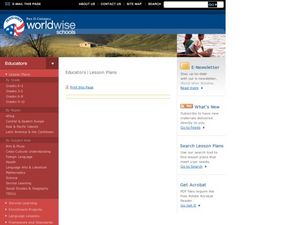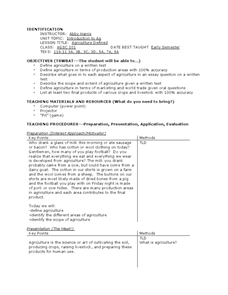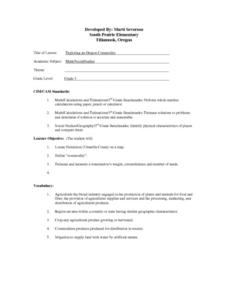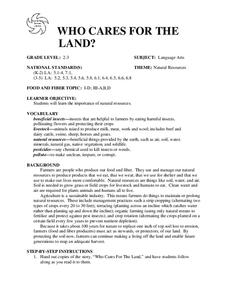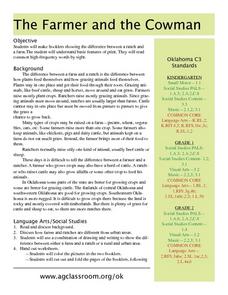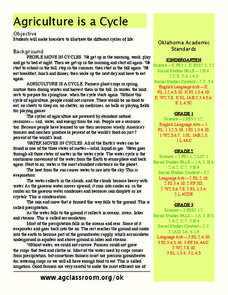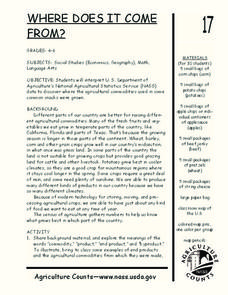Curated OER
Windmills and Blogs: The Impact of Technology in Rural Peru
How does technology affect a community? Research the benefits and consequences of technology in rural Peru. In this technology lesson, learners discuss how the effects of technology. They view a PowerPoint and learn about the Peace...
Curated OER
The Designed World
Students visit a school or public library and study how information is organized. For this information management lesson, students answer a group of questions about the organizational method of the library. Students then practice sorting...
Curated OER
Agriculture Defined
Open your Agriculture 101 course with a lesson on defining agriculture. Guide your class with thought-provoking questions and discussion. Give them time to play the card game, "Pit" in order to experience commodity exchange. This is a...
Curated OER
DNA: The Human Body Recipe
Students describe DNA and the roles in which engineers are involved with the human body. For this DNA lesson students participate in a class demonstration.
Curated OER
The Scientific Method
Young scholars examine the Scientific Method. They will discover the value in being observant, organized, and thorough with regard to science. They will also explore how these traits can serve them well in other areas of life.
Curated OER
Minoan Pottery - A History Lesson
Accent your next ancient pottery art project with easy-to-follow background information. An article describes the background, significance, and history of Minoan Pottery. It includes links to images, sites and ideas. Tip: This is a great...
Curated OER
Career Bingo
Students explore various careers in agriculture. As a class, they match careers with the definitions of jobs. Students create their own Bingo card by placing given pictures of careers on the paper. After several careers are discussed,...
Curated OER
Where it Grows
First graders identify the commodities of Oregon and produce a map of the different commodities in different regions.
Curated OER
Exploring and Oregon Commodity
A fun (and delicious!) lesson teaches measurement to your third graders. They work in small groups to first predict, then to measure the weight, circumference, and number of seeds found in a watermelon. Everyone gets to eat watermelon...
Curated OER
Agriculture & Alaska's Economy
Students examine Alaska's agriculture numbers from previous years. They answer questions based on Alaska's production levels.
Curated OER
Prairie People
Eighth graders interview a person who explains the lifestyles of people who lived on the prairies in the eighteenth and nineteenth centuries. They examine how today's lifestyles impact the environment and write up what they learned.
Curated OER
Music for Alice
Third graders explore Japanese culture. They read the story Music for Alice. Students write a paragraph defining what happiness means to them. They discuss Alice's culture and their own cultures. Students create a brochure about Japanese...
Curated OER
When Disaster Strikes: Flooding in Pakistan
Young scholars complete various activities after reading about flooding in Pakistan. For this lesson on humanitarian efforts, students read about flooding that occurred in Pakistan, discuss what they have read, and synthesize the...
Curated OER
WHO CARES FOR THE LAND?
Students explore the importance of natural resources. They are given copies of the story, "Who Cares For The Land," and students follow
along as the teacher reads it. Students identify the key points in the story. (Soil, water and air...
Curated OER
The Farmer and the Cowman
What is the difference between a ranch and a farm? After reading and discussing the provided background information, young agriculturalists will color, cut, and create neat little booklets that show the differences between ranches and...
Curated OER
Cricket Wars
Students investigate crickets in their habitat. In this insect lesson, students create a cricket habitat by using a glass jar with grass clippings and cloth. Students observe how crickets interact with each other and their eating habits.
Curated OER
What is the history of rice in the United States?
Fifth graders become familiar with the history of rice and create a board game. In this rice lesson, 5th graders understand the history of rice through the playing of a game. Students use vocabulary words related to the...
Curated OER
Agriculture is a Cycle
Young scholars explore cycles in nature. In this cross curriculum agriculture lesson, students define "cycle" and research weather and planting folklore. Young scholars make a bracelet in which individual colored beads represent the many...
Curated OER
Oklahoma Wheat on the World Market
Sixth graders explore profit and loss in the wheat trading market. In this sixth grade mathematics lesson/social studies lesson, 6th graders play a “Wheat Market Trading Game” in order to investigate the concept of supply and...
Curated OER
Back to the Farm
Students complete a family tree. In this farming and ranching lesson plan, students define the term genealogy, learn how to create a family tree, and fill in a family tree with the help of their parents making sure to note if any...
Curated OER
Cultural Rituals
Fifth graders explore cultural rituals. In this cultural rituals lesson, 5th graders discover different cultures way of celebrating rice. Students gain information about festivals in the US, Indonesia, Thailand, and Japan. Students...
Curated OER
Where Does It Come from?
Students read articles about various agricultural products and create a map using the statistics in the article. In this agricultural statistics lesson plan, students look at the geography of the country and which products come...
Curated OER
How Groundhog's Garden Grew
Students answer questions based on Bloom's Taxonomy after reading the book, How Groundhog's Garden Grew, by Lynne Cherry. In this reading comprehension lesson, students respond to 6 questions, one per taxonomy level, to...
Curated OER
Comparison of American Colonies
Learners explore the lifestyles of the American colonies. They conduct various activities according to their grade level including jigsaw research and creating a poster. Lesson includes primary source readings related to the topic.
